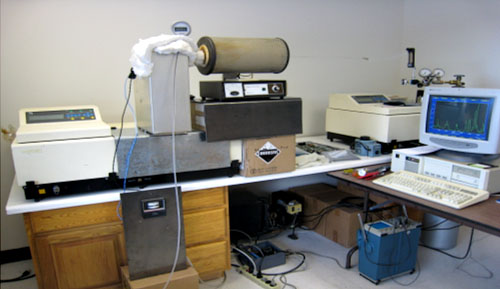Introduction:
The Waste Electric and Electronic Equipment Directive (WEEE Directive) has imposed guidelines on the disposal of many forms of consumer electronics. Efforts are being made to determine how to recycle devices containing a heterogeneous mix of metallic, mineral, organic and inorganic materials. One of the primary concerns is the disposal of printed wire boards (PWB) because many of the compounds in a populated board are toxic.
Analysis:
Peak Analytical, Inc. has conducted studies of volatile emissions resulting from the controlled pyrolysis of PWBs for the purpose of establishing qualitative and quantitative information about the gases evolved. A Fourier transform infrared spectrometer (FTIR) equipped with a heated gas cell was allowed to collect spectra using a kinetics type of data acquisition. In addition, elemental analysis was performed on the crushed circuit board using x-ray fluorescence spectroscopy (XRF).
The PWB pieces were grinded in a mill to homogenize and reduce sample size. A sampling system was set up to include heated surfaces in order to avoid condensation of water vapor and other compounds. The quartz tube containing the PWB sample was enclosed in a tube furnace which could be ramped from room temperature to 950 C in approximately 45 minutes. The entire flow path was maintained at a slightly positive pressure by sweeping pure argon through the system. These flow rates and pressures were continuously controlled. Spectra were acquired at 10 second intervals for a total period of 45 minutes.

photograph of test setup
Results and Observations:
The analysis of vapors resulting from pyrolysis of common PWB pieces including the IC components produced spectra consistent with the following compounds. Calibrations were performed using reference gases of known concentration measured at a known pathlength, temperature and pressure. Quantitative concentrations for the gases below were reported by applying response factors calculated from the spectra of the pure standards, to selected analyte peaks using a peak height measurement.
| carbon dioxide | driven off early in thermal cycle from surfaces |
| Bisphenol A | from epoxy resins in printed circuit boards |
| isocyanic acid | decomposition product from epoxy, polyurethane |
| phenol | decomposition product from epoxy, chip packages |
| 2,4,6-tribromophenol | flame retardant |
| 1-methyl-2-pyridone | |
| dicarboxylic acid, methyl esters | plasticizers |
| carbon monoxide | small molecule decomp. product (late in thermal cycle) |
| methane | small molecule decomp. product (late in thermal cycle) |
| ammonia | small molecule decomp. product (late in thermal cycle) |
| hydrogen cyanide | small molecule decomp. product (late in thermal cycle) |
Elemental information in the order of relative concentration (XRF before pyrolysis)
- Silicon
- Copper
- Aluminum
- Bromine
- Calcium
- Barium
- Lead
- Tin
- Iron
- Titanium
- Nickel
- Zinc
- Sulfur
- Magnesium
- Zirconium
- Silver
Conclusions:
Characterization of the chemical species present in scrap circuit boards is possible using FTIR, which can be quantitative, fast, inexpensive and relatively simple. The FTIR technique is sensitive to organic and inorganic molecules. Such information can be utilized for developing technologies for the recovery of recyclable metals from mineral and organic compounds. The information can also be used for developing scrubbing systems for the handling of toxic vapors.



 Peak Analytical's Gamma Program is designed to help you prevent downtime and, in the event of a breakdown, mitigate your downtime losses with Fast Turnaround Analysis at affordable rates.
Peak Analytical's Gamma Program is designed to help you prevent downtime and, in the event of a breakdown, mitigate your downtime losses with Fast Turnaround Analysis at affordable rates.